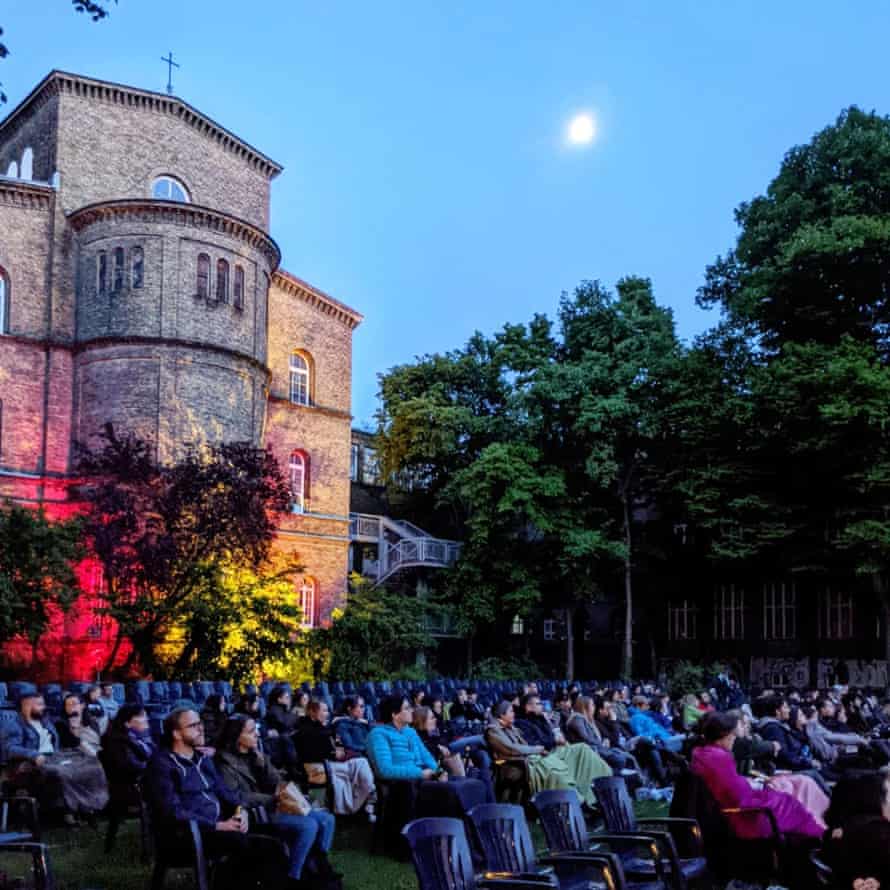It’s Friday night in Berlin and I’m roaming along Kreuzberg’s Oranienstrasse with a friend. We can hardly believe the palpable buzz and sight of dining tables stacked with wine coolers, large white plates laden with schnitzel and asparagus, and people mingling on pavements that have, since November 2020, been almost supernaturally quiet.
It all happened quite suddenly. One minute I was at home, feeling uncertain about exploring the city over the Great Reopening Weekend, and the next – after an excited phone call from a friend – I was on a U-Bahn to Kottbusser Tor, umbrella in hand to fend off the ominous weather, ready to enjoy the experience.
My mixed feelings derived mainly from last year’s summer reopening, which paradoxically led to a series of ever-tighter lockdowns from November onwards, culminating in Berlin’s first curfew (at 10pm) in April. When it was announced that from 21 May, restaurant and cafe terraces could open again, as well as cultural events for up to 250 people (including museums and open air cinemas), plus a selection of outdoor swimming pools, I feared it may have been too early. Germany’s decision to bar British visitors from 23 May was indicative of its more cautious approach to coming out of this last lockdown.
But then the friend called, enthusing about the “amazing” scenes outside, and reassured me this was wholly different to last year. First, half a million residents – around 14% of the city’s population – have been fully vaccinated, with over a million having received first jabs; second, only outdoor spaces were open this time around, as opposed to the indoor “experiments” of 2020; and additionally, everyone needed a negative antigen test, as well as masks when not seated, to mingle at any tables.
So it was that I arrived at Kotti, the gritty but lively square that lies at the heart of Kreuzberg, to meet my friend and find a local test centre; within 30 minutes we had received our (negative) results via email, and were free to roam, drink and dine. It soon became obvious, however, that we were way too late to bag a table anywhere, so we grabbed drinks from one of the area’s ubiquitous spätis (off-licences), and wandered the neighbourhood, soaking up this strange and exciting new atmosphere deep into the night.
The new rules state that alcohol cannot be served after 11pm, presumably to prevent irresponsible drunken mingling, but since the 10pm outdoor curfew has also been lifted, and the rainclouds had dispersed, people drifted towards the leafy banks and illuminated bridges of the Landwehr Canal. Teens and twenty-somethings sat in small circles on the street, the smell of weed mingling with the sounds of laughter and bass (techno, Deutschrap) – it was hard not to feel a little emotional at the partial return of the city’s social life.
The mixed weather, complete with sudden downpours, continued into Saturday and Kreuzberg’s streets were quieter again as we headed out in search of brunch. (Brunch! Remember that?) Some restaurants hadn’t even bothered opening their terraces, but the restaurant garden at the handsome Bethanien Gallery – a quintessential Berlin cultural space that was built as a hospital, became a squat in the 70s, and now showcases politically driven art – was open, complete with protective parasols. We showed our test results, filled in the contact-tracing forms, ordered lunch, and watched fat raindrops bounce dramatically off trees and tables.
Our masked waitress, Karen, had to keep moving tables and items around to protect us from the weather, but admitted that they “were thrilled to be open again,” despite the immediate challenges of mother nature and the newly bureaucratic aspects of the job. After lunch we walked around the venue’s historic and heavily graffitied corridors, and explored the current exhibition, a typically thought-provoking show about mapping as a medium of urban exploration. The whole space, including the exhibition rooms, was eerily quiet; according to my Instagram feed, everyone was at the photogenic Yayoi Kusama retrospective across town.
Lausitzer Platz, a pretty and normally sociable square, was also surprisingly quiet when we strolled through after the exhibition. We found a cafe table easily and enjoyed the novelty of a late afternoon Aperol spritz – still the summer drink of choice judging by the number of people we’d seen clutching them outside bars. By the early evening, our 24-hour test had run out, but back on Oranienstrasse a barman informed us a test was not necessary if we didn’t sit down. Since the limited seating was full anyway, we happily sipped our G&Ts on the street, chatting – at a safe distance – with strangers about how wonderful it was to enjoy some street life again. It was only the second night, but it was already feeling quite normal again.

The weather was a little warmer on Sunday, and the pavements and terraces busier – though still not quite full. Several open-air pools had reopened throughout the city too, but it didn’t feel warm enough to brave them. Since shops are closed on Sundays in Germany, we sauntered around the neighbourhood, relaxing in Görlitzer Park with some takeaway dumplings, and booked an evening movie at Bethanien’s Open-Air cinema (which didn’t require a test, since it was socially spaced).
The film wasn’t too great, but it didn’t matter. We were enjoying a cultural event, outside, with a hundred or so others. The rain, happily, had held off all day, and it was difficult not to feel the warm glow of some of our freedoms returning. With indoor dining, hotels, fitness studios and other establishments also set to reopen in two stages next month (4 and 18 June) – under certain conditions, and as long as incidence rates stay down and vaccinations continue at a decent pace – full corona lockdowns might even, finally, be a thing of the past.





